Despite large-scale technological investment, workforce productivity growth remains low. Organisations face an evolving business environment with the competitive pressures of building trust and seeking efficiency and profitability. Maximising the productivity benefits of technology is not just a case of the right investment strategy, it requires the right human skills via a motivated workforce. Policy makers should focus on four imperatives: rethink productivity measurement to account for societal benefits; accelerate technology adoption; drive workforce reskilling; and promote effective people management practices.
Challenge
Growth in workforce productivity, by any measure, remains low. Rates in 29 of the 30 countries reported by the OECD fell significantly in the mid-2000s and have stayed low ever since, despite large-scale technological investment (currently running at over US$3 trillion per year).[1]
There are vast potential benefits available from new technologies. Augmented and Artificial Intelligence (AI) allows organisations and individuals to work at a more efficient, effective and precise rate. PwC research shows GDP could be up to 14% higher in 2030 as a result of AI alone – the equivalent of an additional $15.7 trillion.[2]
The return on investment from new technology requires dramatic improvements in workforce productivity which can only be sustained by changes in how ‘work gets done’, how people are engaged and reskilled and how businesses take a purpose-driven approach to deliver on longer term societal benefits.
Digital transformation is leading to worsening skills mismatches which in turn create a drag on productivity. 79% of CEOs are worried about the availability of key skills.[3] The EU white paper on Growth of Europe (2017) estimates a potential gap of 700,000 IT workers in the EU by 2030.[4] This lack of competency in some industries and the associated lost revenue is costing up to 200,000 Euros per vacant job per year.[5] By 2030 US$8.5 trillion in unrealised revenue will be attributed to talent shortages – with US$162 billion on this just in the US.[6]
At an organisational level, poor productivity erodes competitiveness and profitability. It might appear that measuring productivity improvement would be easy given the abundance of input (e.g workforce and technology) and production output data that organisations hold and produce, but there are significant pitfalls, not least the need to shift measurements to sustainable purpose driven ‘outcomes’ and the ongoing tension between productivity, jobs and societal trust.
Trust is a critical issue for business leaders and policy makers alike. Large segments of the population feel left behind by economic progress and the displacement of workers caused by automation will exacerbate the issue unless care is taken. A focus on productivity needs to ensure that communities and workforces are supported, encouraged and benefit from improvements. Progress on average will not be a sufficient measure of success.[7]
Proposal
This proposal is for four interrelated policy actions focused on driving workforce productivity growth alongside strengthening the recognition of societal benefits delivered through paid work.
● Policy action 1: The G20 should establish a working group (across the T20, B20 and L20) to identify the underlying drivers and trends in workforce productivity at an organisational, industry, national and subnational level. This should include the factors which may drive down productivity growth yet deliver significant societal benefits. These should form the basis for consistent national and subnational measurement and reporting to inform policy decisions.
● Policy action 2: The G20 should seek to build increased awareness of the benefits from the adoption of advanced technologies to society. These benefits include the ability to free-up resources at national and subnational levels and solve societal challenges.
● Policy action 3: The G20 should act collectively to identify the factors that will drive the improvement of workforce skills across one interconnected global labour market and in turn drive productivity at industry, national and subnational levels. This will require the formation of a G20-led global working group. The G20 should publish a ‘Blueprint For Skills’ statement which signals the intent of all G20 members to take action and act consistently to deliver improved workforce skills across all nations, while still enabling individual G20 members to deliver on their local education/skills building priorities – whether they be basic literacy, increasing female workforce participation in rural locations or access to primary education.
● Policy action 4: The G20 should recognise the dual societal and productivity impacts of effective people management practices, take action to collectively agree on standards for working practices, and promote the understanding and adoption of workforce management goals across the member nations.
Policy action 1: Establish a G20 working group to identify the underlying drivers of workforce productivity and those factors which reduce productivity growth but deliver societal benefits.
Today’s macro measures of workforce productivity highlight the mismatch between the promises of technology and the benefits delivered so far, but contribute little to helping policy makers deliver improvements.
The proliferation of technologies geared towards replacing today’s work is happening at exponential rates – yet measurement of its impact is beset by difficulties. For example, many of the services generated by the hi-tech industries are free to the user so are not recognised in GDP. Societal benefits of increased living standards and reduced costs are not included.[8]
Aggregated and backwards looking measures also mask emerging societal issues such as the displacement of workers by technology. Long-term projections of AI’s impact on jobs frequently include mass unemployment, but potentially more difficult is the occupational polarization of persons moving from mid-skilled jobs into lower-wage work that is harder or less cost-effective to automate with technology.[9]
Compounding the productivity issue, workers have more to fit into their paid working hours. This unproductive downtime is often driven by regulation and is intended to provide a societal benefit. Take for instance, mandatory training (e.g., training to help bank employees identify money laundering), paid travel time, paid ‘on call’ hours for certain roles, or paid sick or parental leave – all designed to either protect workers or society.[10] Different markets and industries have different norms for unproductive (or not directly productive) but paid hours, adding to the difficulty of comparing productivity growth using today’s measures.
Research has also shown the importance of linking measures of wellbeing with productivity growth.[11] While traditional measures may not incorporate wellbeing, some countries are starting to recognise the need to expand measurements.[12]
Policy action 1:
The G20 should establish a working group (across the T20, B20 and L20) to identify drivers and trends in workforce productivity at an industry, national and subnational level. Bringing together policy makers with economists, technologists, labour unions and businesses across the G20, this working group should:
● make recommendations for corporate level public reporting on productivity and controllable factors that drive it within an organisation, especially how significant investments in machines/technology, automation and AI will contribute in a way that is consistent with an organisation’s societal purpose.
● develop a globally consistent framework to measure controllable factors that drive productivity, including: technology investment and adoption; skills availability; workforce mobility and adaptability; workforce motivation and management practices; and infrastructure alignment. This should form the basis for consistent national and subnational measurement and reporting to inform policy decisions.
● highlight factors which may drive down productivity yet deliver significant societal benefits.
● use systems thinking approach to help determine how individual factors interplay and identify potential unintended consequences for industries, countries, regions and cities.[13][14]
Policy action 2: The G20 should build increased awareness of the societal benefits and challenges from advanced technology adoption.
Whereas most of the current technological breakthroughs mainly affected B2C (user applications, internet trading, social media), the next wave of digitisation affects B2B and will focus on productivity gains. This digitisation will drive massive labour market transformation across the globe through advanced technologies including AI and robotics to replace and augment work currently done by humans (Exhibit 1).
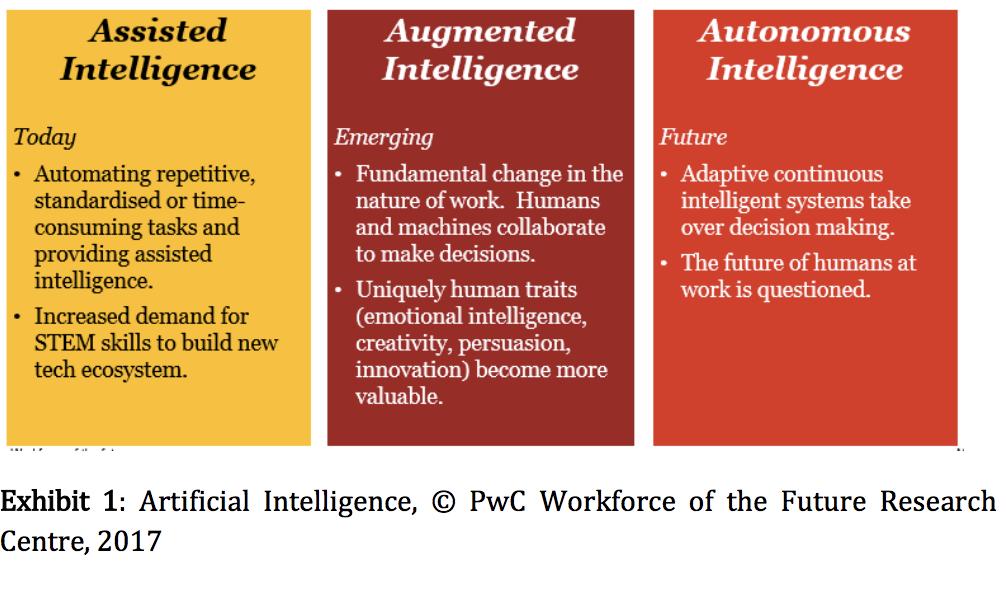
As Exhibit 2 shows, the estimated proportion of existing jobs at high risk of automation by the early 2030s varies significantly by country. These estimates range from only around 20-25% in some East Asian and Nordic economies with relatively high average education levels, to over 40% in Eastern European economies where industrial production, which tends to be easier to automate, still accounts for a relatively high share of total employment. Countries like the UK and the US, with services-dominated economies but also relatively long ‘tails’ of lower skilled workers, could see intermediate levels of automation in the long run.[15 ]
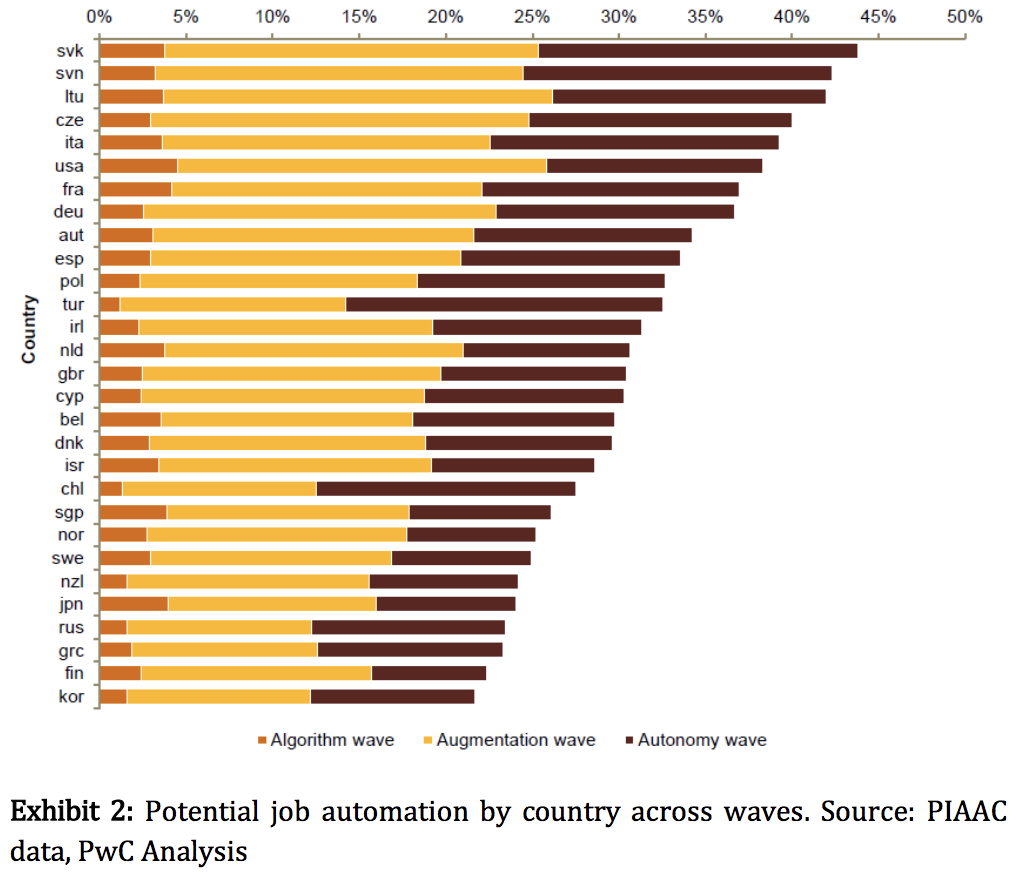
Digitisation and automation can also be turned into key drivers for prosperity. The net long-term benefits to society are compelling – despite negative impacts along the way – with the potential to free-up resources at national and community levels and solve societal challenges including: ageing populations, climate change, resource scarcity, and poverty.
PwC’s research into the global benefits of AI shows GDP could be up to 14% higher in 2030 as a result of AI alone – the equivalent of an additional $15.7 trillion. Of this, $6.6 trillion is likely to come from increased productivity with over 55% of total GDP gains from AI over the period 2017 – 2030.[16]
Organisations will, however, face significant inertia factors as they seek to benefit from new technologies. Businesses face restructuring and adjustment costs as they implement information technology solutions. For example, a move from human-centric, to automated ‘dark warehouses’ (autonomous facilities without humans, where robots work alone in the dark) requires significant investment to benefit from productivity gains, especially when human workers are still relatively cheap in some markets.[17] Invariably, adopting technology requires the right skills – from tech-savvy leaders to identify the opportunity to broad workforce skills to work alongside technology in new ways.
Policy action 2:
The G20 should seek to build increased awareness of the benefits to society of advanced technology adoption. This can be achieved by:
● the foundation of a G20 advanced technologies foresight institution with a mandate to identify the societal advantages and disadvantages derived from adopting advanced technologies, alongside the roadblocks for technological adoption, in an interconnected global economy. It should publish these findings in a widely accessible and easily understandable way with an aim to build awareness around the opportunities and risks from technology.
● this institution being mandated to provide research capabilities at the subnational level in order for communities to better understand and manage their individual challenges in increasingly complex and interdependent environments.
Policy action 3: Identify factors that will drive improved workforce skills across one interconnected global talent market and act consistently to deliver improved workforce skills across the G20.
The world already faces alarming skills mismatches – with a high vacancy rate in technical jobs throughout the western world. The drive towards the use of technology to increase workforce productivity suffers from this mismatch – and also exacerbates it.
In the industrialised world, most of the current workforce was educated between 1970 and 2000. Many technologies that are ubiquitous today did not exist and the internet was in its infancy. Now, as the digital transformation of the global economy occurs, more high-tech skills are required. The BSA Foundation estimated in 2017 that American software-related jobs were growing at 6.5% annually, compared to 3.9% generally.[18] The European Union Commission estimates that there will be a high-tech skills gap of more than 500,000 unfilled positions by 2020.[19]
Bringing together the creative, sensory and motoric skills of the human worker, and the efficiency of digital solutions will drive productivity.
Humans are able to respond to unusual situations with innovation and flexibility. As machines take over codifiable work; value from human workers will increasingly rely on soft skills alongside digital skills. Businesses find skills like problem solving, leadership, adaptability and creativity and innovation harder to find (see Exhibit 3).
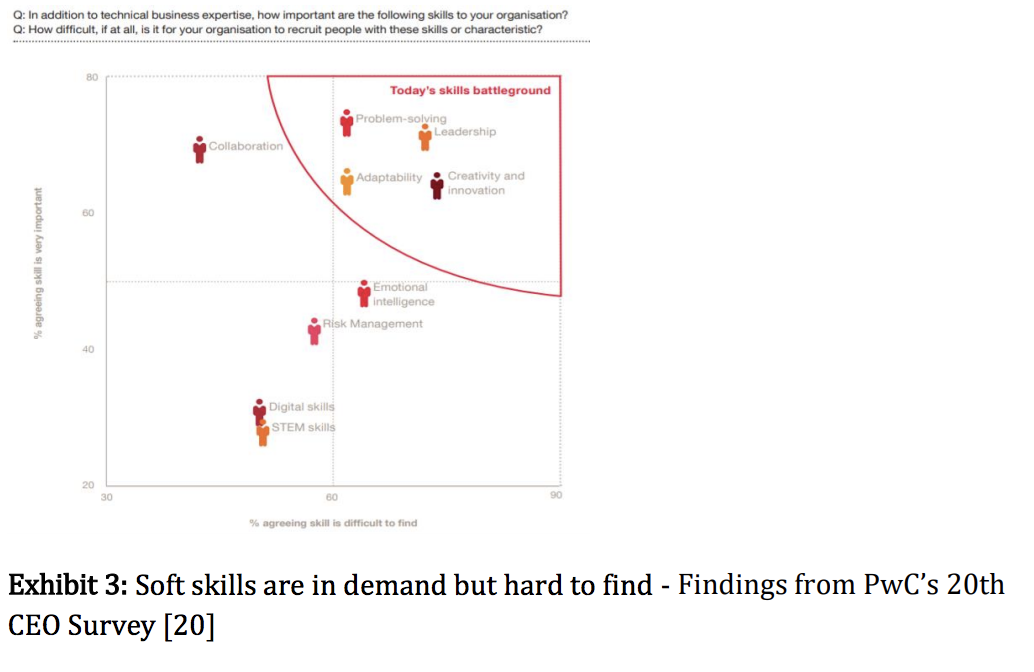 Humans augmented by machines are more effective than either separately. Organisations are faced with rebalancing their workforces as they start to unbundle jobs into tasks and then consider more clearly how the work gets done.[21]
Humans augmented by machines are more effective than either separately. Organisations are faced with rebalancing their workforces as they start to unbundle jobs into tasks and then consider more clearly how the work gets done.[21]
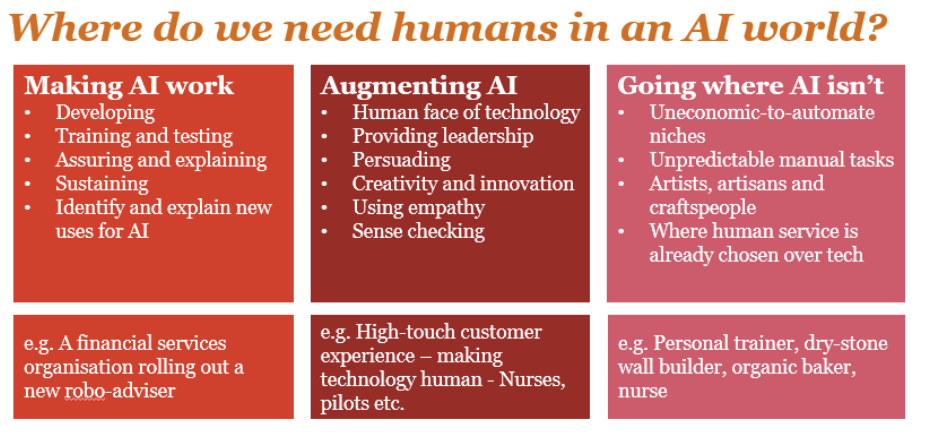
Exhibit 4: Where do we need human workers in an AI enabled world? © PwC Workforce of the Future Research Centre
There are clear benefits for organisations to invest in reskilling their workers. A lack of key skills is keeping 79% of CEOs awake at night according to PwC’s latest CEO survey and it’s one of their top 3 worries.[22] 46% of CEOs say their number-one priority to remedy the issue is reskilling workers they currently have – far ahead of the 18% who will focus on hiring from outside industry or strengthen ties with education (17%). CEOs need to be much clearer about reskilling for the future and what that really means in their organisation – for instance which skills will be valued and rewarded and which will not be needed.
The World Economic Forum estimate a cost of US$24k per head to reskill displaced workers in corporate America – but this cost should be placed in the context of the alternatives: severance costs for laid-off workers, hiring and onboarding costs for new workers plus the rising costs of in-demand skills and unproductive time spent trying to find them.[23] The good news is that employees are willing to reskill; they say that they’d happily spend two days per month on training to upgrade their skills, if offered by their employer.[24]
Policy makers need to focus on upskilling programs that promote lifelong learning and adaptability. An investment in education will support a decrease in anxiety about automation replacing jobs. The T20 policy brief ‘Future of Work and Education for the Digital Age’ identifies that whilst school curricula could be adapted locally, it is important to ensure long-term validity and global acceptance of skills for one interconnected labour market. Digital skillsets as well as social competencies need to be co-designed and constantly tested in close cooperation with businesses and in support of the aspiration to lifelong learning.[25]
Talent shortages also place a burden on communities, in the form of unemployment, business failures, and an overall decline in quality of life.
Putting aside the political challenges, which are substantial – it’s an easy financial calculation for Governments to make. Skills mismatches have a direct impact on a nation’s GDP, taxation revenues and social safety net bill. Low skilled workers cannot take up needed roles without reskilling. Jobs go unfilled and organisations are less productive and trade generates less tax.
Policy action 3a:
The G20 should act collectively to identify factors that will drive improvement of workforce skills across one interconnected global labour market and in turn drive productivity at industry, national and subnational levels. This will require:
● the formation of a G20-led global working group (across T2, B20 and L20) with a mandate to work with businesses, labour unions and job aggregators/platform recruitment industry and research bodies to understand and widely communicate job-related labour-market impacts of skill gaps and mismatches.
● the establishment of a common framework for research to understand the dynamics and projections of labour markets and skills mismatches across all geographies, societal layers including the community level, as well as industries, and continuously validate the long-term outlook. Specifically this would include the development of big data analytics solutions to cater for the complex labour market dynamics. The G20 should ensure that its analytics capability is commonly accessible for local communities to develop customised solutions and share best practices.
● encourage broad transparency of the types of skills and jobs that each economy (including subnational economies) is most likely to need in the short, medium and longer term. This clarity will allow workers and students to make better choices around building their skills and managing their careers.
Policy action 3b:
The G20 should act consistently to deliver improved workforce skills across all members. This will require:
● The agreement and publication of a G20 ‘Blueprint For Skills’ statement which signals the intent of all G20 members to take action to:
- restructure education curricula and skills development funding in light of changing skills needs and longer working lives. We can no longer expect a three-stage life with education succeeded by work and retirement – today’s world will see workers need to train and retrain as they work for many more years.[26] Policy makers should incentivise businesses and the education sector (including vocational training) to align with high-growth skill needs.
- incentivise and encourage individual citizens to invest in their own skills and education, whether employed or unemployed.
- invest in targeted reskilling initiatives working with businesses, unions, industries and subnational and national government bodies. Luxembourg’s Digital Skills Bridge provides one example of how stakeholders can align funding and outcomes successfully.[27]
- align policies and immigration hurdles and facilitate cross-border or remote virtual working via global social recruiting, allowing real-time global accessibility of jobs. Align national policies and regulations to allow more flexible working models and support businesses to acquire critical resources as they are needed.
- encourage reporting and knowledge sharing amongst organisations and provide incentives to do so including requiring all medium and large businesses to report on the investment they are making into upskilling their employees and the nature of that training.
Policy action 4: Recognise the dual societal and productivity impacts of effective people management practices, take action to collectively agree on standards for working practices, and promote the understanding and adoption of workforce management goals.
Looking at country workforce productivity, it’s evident that more hours worked do not directly guarantee higher productivity per country.[28] There is considerable evidence that work performance plunges when people toil for extended periods without a break.[29] Productivity in the US is rising by just 1% annually, despite employees working more hours. [30] Labour productivity in the Euro area was also just at 1% in 2017.[31]
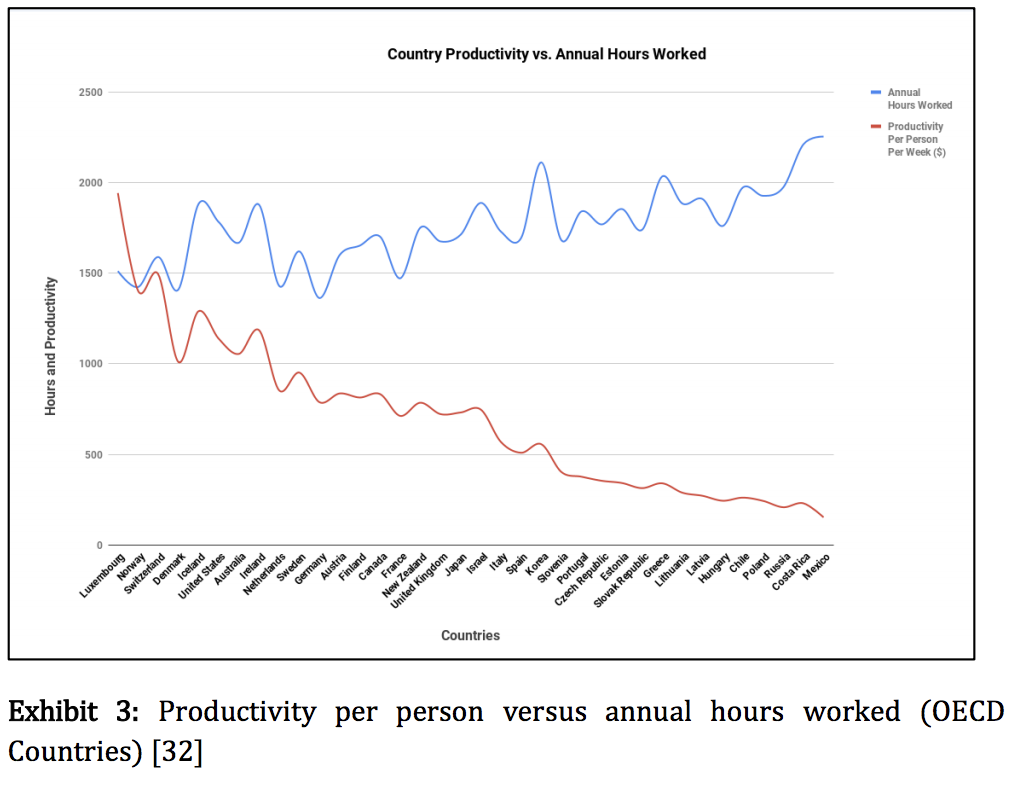
Today’s corporate leaders talk increasingly about ‘purpose’ and their organisation’s place in society. 56% of CEOs strongly agree that they will increasingly focus on purpose.[33] Yet the business world’s focus on short term financial reporting coupled with the expectations from the markets that automation will bring efficiency gains will severely test their resolve. Being more purpose-led impacts organisations choices around productivity and their benevolent responsibility to their workforces. Corporate leaders need to clearly articulate how they will balance the right level of productivity with the need to build trust with society over the longer-term. Without this honest narrative for the future, CEO platitudes about reskilling will ring hollow.
Investment in technology is only as successful as the willingness and ability of the workforce to adopt changes in ways of working. Clearly defining what employees need to do and what is expected of them and granting a sense of autonomy in how that work is done can lead to better job performance.[34] According to a study of nurses, perceived role clarity was negatively correlated with voluntary turnover and job tension, and positively associated with work satisfaction.[35]
Misaligned incentives with an aggressive focus on increasing workforce productivity and profitability at all costs, can crowd out attention to ethical, quality, safety and societal concerns and create unintended consequences.[36] These factors will lead to changing the way people are measured, incentivised and rewarded. Increased focus on improving employee happiness may be a smart bet, employee happiness has been linked to increased productivity. One study by Social Market Foundation found that productivity of happy employees was boosted by almost 20%.[37]
Policy action 4:
The G20 should recognise the dual societal and productivity impacts of effective people management practices, take action to collectively agree on standards and promote the understanding and adoption of workforce management goals. The G20 members should take action to:
● collectively agree on and sign up to minimum working rights across all G20 countries. This agreement should attempt to guard against retrograde people management practices and working conditions such as unfair penalties and workplace practices that undermine human dignity.
● identify and publish a set of workforce management practice goals across G20 nations (similar to SDGs) that organisations will be recognised for achieving. These would include: reskilling workers, wellbeing and fair pay practices along with leading management practices that measurably improve work performance and worker inclusion.[38]
● individually encourage large-scale employers to see the potential benefits for flexible work practices and remote working and to improve business’ integration into planning for infrastructure investments. This helps to free up stretched infrastructure resources.
References
1. F. Forrester Forecasts 5.1% Growth In Global Tech Market In 2018 And 4.7% In 2019, January 2018, Available at: https://go.forrester.com/blogs/forresterforecasts-5-1-growth-in-global-tech-market-in-2018-and-4-7-in-2019/
2. PwC’s Global Artificial Intelligence Study, Sizing the prize: What’s the real value of AI for your business and how can you capitalise?, 2017, Available at: https://www.pwc.com/gx/en/issues/analytics/assets/pwc-ai-analysis-sizing-theprize-report.pdf
3. PwC’s 22nd Annual Global CEO Survey, 2019, Available at: https://www.pwc.com/gx/en/ceo-survey/2019/report/pwc-22nd-annual-globalceo-survey.pdf
4. The Future of Europe, European Commission, Brussels, 2017, Available at: https://ec.europa.eu/commission/sites/betapolitical/files/white_paper_on_the_future_of_europe_en.pdf
5. B. Diosadado, The Price of Vacancy: The Cost of Unfilled Technology Jobs, Forbes, 22 June 2017, Available at: https://www.forbes.com/sites/forbestechcouncil/2017/06/22/the-price-ofvacancy-the-cost-of-unfilled-technology-jobs/#17de9cb45747
6. J. Laouchez, W. Penk, Yannick Binvel, A. Guarino, M. Franzino, 2030: The 8.5 trillion talent shortage, Korn Ferry Institute, 9 May 2017, Available at: https://www.kornferry.com/institute/talent-crunch-future-of-work
7. Navigating the SDGs: a business guide to engaging with the UN Global Goals, PwC, 2016, Available at: https://www.pwc.com/gx/en/sustainability/publications/PwCsdg-guide.pdf
8. S.P. Chan, GDP ‘not fit for purpose’ in digital age, says Google, 23 April 2017, Available at: https://www.telegraph.co.uk/business/2017/04/23/gdp-not-fitpurpose-digital-age-says-google/
9. F. Levey, Computers and populism: artificial intelligence, jobs, and politics in the near term, Oxford Review for Economic Policy, Volume 34, Number 3, 2018, Available at: https://www.russellsage.org/sites/default/files/gry004.pdf
10. OECD, PF2.1: Key characteristics of parental leave systems, Available at: https://www.oecd.org/els/soc/PF2_1_Parental_leave_systems.pdf
11. Creating Common Purpose, PwC, Available at: https://www.pwc.com/gx/en/issues/trust/realigning-business-economies-andsociety.html
12. Scoop Parliament, Wellbeing of NZers at the heart of Budget priorities, 13 December 2018, Available at: https://www.scoop.co.nz/stories/PA1812/S00165/wellbeing-of-nzers-at-theheart-of-budget-priorities.htm
13. J.A. Curtatone and M. Esposito, A systems-thinking approach to public policy eschews linear model for more holistic understanding of decision-making, 25 September 2014, Available at: https://blogs.lse.ac.uk/impactofsocialsciences/2014/09/25/systems-thinkingapproach-to-public-policy/
14. T20 Policy Brief, Accelerating Labour Market Transformation, PwC, 2017, Available at: https://www.g20-insights.org/policy_briefs/accelerating-labour-markettransformation/
15. Will Robots Really Steal Our Jobs, PwC, 2018, Available at: https://www.pwc.co.uk/economic-services/assets/international-impact-ofautomation-feb 2018.pdf
16. PwC’s Global Artificial Intelligence Study, Sizing the prize: What’s the real value of AI for your business and how can you capitalise?, 2017, Available at: https://www.pwc.com/gx/en/issues/analytics/assets/pwc-ai-analysis-sizing-theprize-report.pdf
17. E. Xiao, From Dark Warehouses to Delivery Robots, Chinese ecommerce figures out models of automation, 2017, Available at: https://www.techinasia.com/jd-xlogistics-unmanned-warehouses
18. The Growing $1 Trillion Economic Impact of Software, software.org BSA Foundation, September 2017, Available at: https://software.org/wpcontent/uploads/2017_Software_Economic_Impact_Report.pdf
19. The High-tech Skills Gap In Europe Will Reach 500,000 In 2025 With A Strong Polarisation Of Skills Needed, e-leadership, 2017, Available at: https://eskillsscale.eu/news/single-view/the-high-tech-skills-gap-in-europe-will-reach-500000- in-2025-with-a-strong-polarisation-of-skills-needed.html
18. T20 Policy Brief, ‘Accelerating Labour Market Transformation, H. Kayser, 2017, Available at: https://www.g20-insights.org/policy_briefs/accelerating-labourmarket-transformation/
19. D. Tharp, What Cyborg Chess Can Teach Us About The Future Of Financial Planning, 24 July 2017, Available at: https://www.kitces.com/blog/cyborg-chess-advisorteach-about-future-financial-planning/
20. PwC’s 20th Annual Global CEO survey, 2017, Available at: https://www.pwc.com/gx/en/ceo-survey/2017/pwc-ceo-20th-survey-report2017.pdf 21. B. Sethi and C. Stubbings, Good Work, 2019, Available at: https://www.strategybusiness.com/feature/Good-Work
22. PwC’s 22nd Annual Global CEO Survey, 2019, Available at: https://www.pwc.com/gx/en/ceo-survey/2019/report/pwc-22nd-annual-globalceo-survey.pdf
23. World Economic Forum, Revolution: Industry-led Action for the Future of Work, 2019, Available at: https://www.weforum.org/whitepapers/towards-a-reskillingrevolution-industry-led-action-for-the-future-of-work
24. C. Duarte, D. Staley, and B. Sethi, Our Status with Tech at Work: It’s Complicated, 2018, Available at: https://www.pwc.com/techatwork
25. T20 Policy Brief, Future of Work and Education for the Digital Age: Demographic dividend or nightmare: A three-part strategy for addressing massive entrants to the workforce, PwC India, 2018, Available at: https://www.pwc.com/gx/en/issues/assets/pdf/future-of-work-educationdigital-age.pdf
26. L. Gratton and Andrew Scott, The 100-Year Life: Living and Working in an Age of Longevity, 2016, Available at: https://www.100yearlife.com/
27. Skills Bridge, 2019, Available at: https://www.skillsbridge.lu/ 28. J. Pinches, The Most Productive Countries in the World: 2017, 2018, Available at: https://www.expertmarket.co.uk/focus/worlds-most-productive-countries-2017
29. R. Friedman, Dear boss: Your Team Wants You to Go on Vacation, 2018, Available at: www.hbr.org/2015/06/dear-boss-your-team-wants-you-to-go-on-vacation.
30. United States Department of Labor, Overview of BLS productivity stats, 2018, Available at: https://www.bls.gov/bls/productivity.htm
31. Is Europe’s Productivity Glass Half Full or Half Empty, 2018, Available at: https://archive.intereconomics.eu/year/2018/2/is-europes-productivity-glasshalf-full-or-half-empty/
32. Hannah Whitfield, The Most Productive Countries in the World: 2017, 2018, Available at: https://www.expertmarket.co.uk/focus/worlds-most-productivecountries-2017
33. PwC’s 20th Annual Global CEO survey, 2017, Available at: https://www.pwc.com/gx/en/ceo-survey/2017/pwc-ceo-20th-survey-report2017.pdf
34. Steven R. Bray, Lawrence R. Brawley, Role Efficacy, Role Clarity, and Role Performance Effectiveness, 2002, Available at: https://journals.sagepub.com/doi/abs/10.1177/104649640203300204
35. Thomas F. Lyons, Role Clarity, need for clarity, satisfaction, tension, and withdrawal, 1971, Available at: https://www.sciencedirect.com/science/article/pii/0030507371900079
36. PwC, Making executive pay work: The psychology of incentives, 2019, Available at: https://www.pwc.co.uk/services/human-resource-services/insights/makingexecutive-pay-work.html
37. Camille Preston, Promoting Employee Happiness Benefits Everyone, 2017, Available at: https://www.forbes.com/sites/forbescoachescouncil/2017/12/13/promotingemployee-happiness-benefits-everyone/#36de3861581a
38. Department of Communications and the Arts, Bureau of Impacts of 5G on productivity and economic growth, 2018, Available at: https://www.communications.gov.au/file/35546/download?token=Bc3Re9v8
Appendix
PwC’s purpose is to build trust in society and solve important problems. PwC is a network of firms in 158 countries with more than 250,000 people who are committed to delivering quality in assurance, advisory and tax services. PwC refers to the PwC network and/or one of its member firms, each of which is a separate legal entity. Please see www.pwc.com/structure for further details.








